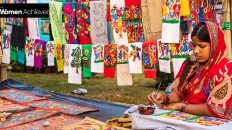Women in sports require more attention than it is right now
Women in sports have recently been making the proper kind of noise in the world of sports. Female athletes not only defy gender norms and boldly represent their nation in major leagues and international sporting competitions, but they also triumph and take home the gold. Female sports comes with taking farces where women’s beauty is mistaken for gentleness and docility, and feeble had to fight long battles to pedal their way to greatness in sports in contradiction to the belief that exercise will cause their muscles to grow like men’s, with tanned skin and a body unable to withstand shocks. The physiology of women athletes and how their bodies were viewed as objects were two additional major deterrents to participation in sports.
However, dispelling all myths, women have consistently participated in leisure sports and fitness activities since 1970 and have demonstrated their strength. Due to the prohibition of discrimination based on gender, race, and physical disability in open, amateur sports, Title IX and the Amateur Sports Act of 1972 made it possible for women to engage in the traditionally male-dominated institution of American sports.
In her book “Playing the Game: Sport and the Physical Emancipation of English Women 1870-1914,” historian Kathleen E. McCrone says. Running, jumping, and climbing could harm their reproductive systems and reduce their attractiveness to men.
We see that the role of women in sports has been quite admirable in India, a country where there is generally a lax attitude towards sports, lack of encouragement towards a sports-oriented mindset from family due to traditional ways of living, and despite the limited support from the government both in infrastructure and morale boost. We also celebrate this. In order to play for their country, they overcame obstacles and battled against all odds.
There are women who have forged steadfast paths, fought valiantly, and represented the nation abroad. P.T. Usha, Saina Nehwal, Mary Kom, and Sania Mirza are a few who gained attention and recognition. The achievements of a select few, however, are no less impressive than their more well-known contemporaries.
Ishita Malviya, the first Indian woman surfer, Mira Erda, the country’s first female Formula One racer, Archana Sardana, the nation’s first BASE (Building Aerial Span Earth) jumper, and Koneru Humpy, the world women’s chess champion are just a few of the individuals who are pursuing their goals with vigor and passion and are hooked on to the pursuit of excellence.
For many women, participating in sports is a way of life rather than a leisure activity. When seen as a professional athletic career, professional sporting achievement might occasionally lack public relevance yet develop a personal perspective. According to the Wall Street Journal, revenue from women’s games was $50.8 million from 2016 to 2018, compared to $49.9 million for men’s games. Surprisingly, just 5% of sports segments are occupied by women, compared to 92% of males and 3% of both. Yet alas! Even now, gender parity, less media attention, and lower pay for women are universal problems.
At the most recent e4m-GroupM Let’s Play: Sports marketing summit, a panel discussion on the subject of women’s sport—the future of India—was held. The panelists began the session by recalling the 2017 Women’s Cricket World Cup, where the Indian team narrowly lost the championship match by nine runs, and then they veered off-topic to discuss how different the scenario is now.
The promotion of women in sports must pay close attention to shifting social attitudes. The government and society as a whole must work together to get young girls outside, safe from harm, and able to engage in physical exercise with top-notch coaching and infrastructure.
The pursuit of gender parity is seen as being of utmost importance by the Ministry of Youth Affairs & Sports. Sports exposure for young girls and women will considerably improve their physical health and character, which will then have a positive impact on societal change and our human capital. To advance India’s developmental agenda and strengthen our efforts in the cause, strategic partnerships with the Ministry of Women & Child Development are in the works.






Add comment